Welcome to Iceland, where summer brings a spectacle of wonders that will leave you spellbound. Iceland, with its dramatic landscapes and captivating natural phenomena, becomes a haven for adventurers and nature lovers alike during the summer months. From the breathtaking beauty of cascading waterfalls to the ethereal glow of the Midnight Sun, there’s no shortage of awe-inspiring sights to see in this Nordic wonderland.
Imagine embarking on a journey where every turn reveals a new marvel; from rugged volcanic terrain to pristine black sand beaches kissed by crystalline waves. Picture yourself standing in awe as the vibrant hues of the surrounding nature paint a mesmerising canvas of light and colour. In Iceland, summer is not just a season, it’s a symphony of sensory delights that will leave an indelible imprint on you.
But it’s not just the natural wonders that make Iceland a must-visit destination in summer. It’s also the vibrant cultural scene, where music festivals and outdoor events breathe life into the long days and short nights. From the pulsating rhythms of Reykjavik’s nightlife to the enchanting melodies of traditional Icelandic music, there’s something for everyone to enjoy in this land of contrasts.
Iceland’s cultural heritage is as rich as its landscapes, with traditions dating back centuries. Whether it’s the annual Þjóðhátíð festival in the Westman Islands or the ancient Viking rituals celebrated in remote villages, summer in Iceland offers a glimpse into the country’s fascinating history and heritage. And let’s not forget about the culinary delights that await you in Iceland’s bustling towns and charming villages.
From mouthwatering seafood feasts to hearty traditional dishes like lamb stew and rúgbrauð (rye bread), and even some less appetising delicacies (like fermented shark) Icelandic cuisine is a tantalising blend of tradition and innovation that will delight your taste buds and leave you craving for more.
So if Iceland sounds like the place for you this summer, pack your bags, fuel your sense of adventure, and prepare to embark on the journey of a lifetime. Whether you’re hiking through rugged wilderness, soaking in geothermal hot springs, or simply basking in the otherworldly beauty of Iceland’s landscapes, summer in Iceland promises an experience like no other.
Packing for any new place often begs the question, “What should I wear?” This isn’t the easiest question to answer, but luckily we have you covered, so read on to find out what you need to stuff into your bags to make sure your Iceland summer trip is as spectacular as it can be.
What is the Weather Like in Iceland During Summer?
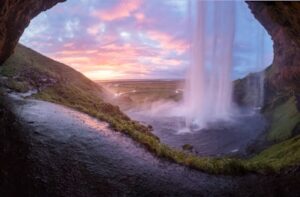
Ah, the million-krona question! Understanding Iceland’s weather in summer can be a bit like trying to predict which character will meet their demise next in a Game of Thrones episode, you never quite know for sure. However, thanks to its unique geographical position, Iceland enjoys a surprisingly temperate climate compared to other places at similar latitudes.
One of the key factors contributing to Iceland’s relatively mild summers is the influence of the North Atlantic Current and the Gulf Stream. These ocean currents, which carry warm water from the Gulf of Mexico and the Caribbean towards the North Atlantic, help to moderate Iceland’s climate, keeping temperatures from plummeting to Arctic extremes.
Another important player in Iceland’s weather game is the mighty jet stream. This high-altitude ribbon of fast-moving air acts as a sort of atmospheric highway, steering weather systems and determining the trajectory of storms. While the jet stream can bring bouts of unsettled weather to Iceland, it also helps to regulate temperatures and can even bring periods of sunshine and clear skies.
That being said, Iceland’s weather can still be notoriously unpredictable, even during the summer months. Temperatures typically range from a cool 10°C to a mild 15°C (50°F to 59°F). But don’t let that fool you; Mother Nature can throw in some surprises like sudden rain showers or bursts of sunshine, just to keep things interesting.
So while you may not need to pack your parka and snow boots for a summer trip to Iceland, it’s always wise to come prepared for a bit of everything. After all, as the saying goes, if you don’t like the weather in Iceland, just wait five minutes; it’s bound to change!
What to Pack For a Summer Trip in Iceland

Preparing for a summer trip to Iceland requires careful consideration of the country’s notoriously unpredictable weather. The key to staying comfortable and ready for anything lies in the art of packing layers. Below, we’ll delve into the essential layers you’ll need in order to make sure you’re ready for Iceland’s diverse landscapes, from its verdant valleys to its rugged volcanic terrain. By mastering the art of layering, you’ll ensure that you’re equipped to tackle whatever weather patterns come your way, allowing you to make the most of your Icelandic adventure.
Outerwear
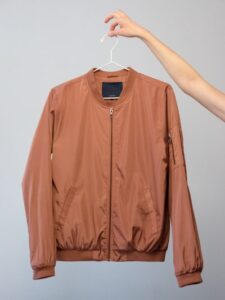
Outerwear refers to clothing designed to be worn over other garments, typically as protection against the elements such as rain, wind, cold, or snow. This category includes a wide range of garments, from coats and jackets to parkas and raincoats.
Depending on the specific climate and conditions, outerwear may be waterproof, windproof, insulated, or breathable.
Waterproof Shell Jacket

This piece of outerwear is your fortress against Iceland’s unpredictable weather. Opt for a jacket with sealed seams and adjustable cuffs to keep the rain at bay. Look for breathable materials to prevent you from feeling like a steamed dumpling on warmer days.
Rain Trousers

Don’t let a little rain dampen your spirits, or your trousers. Invest in a pair of waterproof rain trousers to keep your lower half dry and comfortable. Look for features like articulated knees for better mobility and adjustable waistbands for a custom fit.
Packable Jacket

Iceland’s weather can change faster than you can say Eyjafjallajökull. That’s where a packable jacket comes in handy. Lightweight and compact, it’s easy to stash in your backpack or luggage for those unexpected downpours or chilly evenings.
Hat or Headband

Protect your noggin from the elements with a trusty hat or headband. Opt for a beanie or thermal headband to keep your ears warm and cosy when the temperature drops. Bonus points if it has a built-in windproof liner to prevent icy gusts from ruining your hairstyle.
Gloves

Keep frostbite at bay with a pair of insulated gloves. Look for waterproof and windproof options with touchscreen-compatible fingertips, so you can still snap Insta-worthy photos without exposing your digits to the cold. Pro tip: stash a spare pair in your backpack, just in case.
Layers

As we said earlier, layering is your key to being prepared in Iceland. Below are some the layers to think about when you’re packing those suitcases.
Base Layers
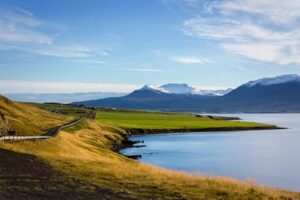
Think of base layers as your secret weapon against sweat and chafing. Iceland may not be the hottest country in the world, but you can still work up a sweat while hiking through its nature. Look for moisture-wicking fabrics like merino wool or synthetic blends to keep you dry and comfortable, no matter how much you’re sweating up a storm.
T-shirts

When it comes to T-shirts, breathability is key. Opt for lightweight cotton or moisture-wicking polyester fabrics to stay cool and comfortable in any situation.
Fleece

A fleece jacket is like a warm hug on a chilly summer evening. Look for options with zippered pockets to keep your essentials secure and adjustable hems for a snug fit. Bonus points if it has a chin guard to prevent chafing when fully zipped up.
Hiking Trousers

Leave the skinny jeans at home. Denim is not really a great fabric to wear in climates that can experience cold temperatures. Denim is typically made from cotton, which is not inherently insulating and can actually absorb moisture, such as sweat or rain, making it feel colder against the skin. In cold climates, moisture retention can lead to discomfort and potentially even hypothermia if the clothing becomes wet and stays wet for an extended period.
Instead, the best bottoms are rugged hiking trousers. Look for options with reinforced knees and seat for added durability, and zip-off legs for versatile wear in changing weather conditions.
Footwear

In a country like Iceland, decent shoes can make or break a situation so below are some footwear items to consider packing.
Hiking Boots
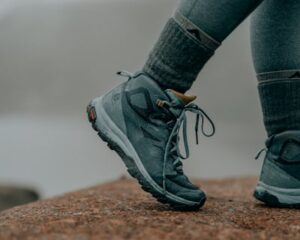
Your feet are your trusty steeds in the Icelandic wilderness, so invest in a pair of quality hiking boots. Look for options with waterproof membranes like Gore-Tex to keep your feet dry in wet conditions, and sturdy Vibram soles for traction on slippery terrain.
Walking Shoes

For urban exploration or casual strolls, a pair of comfortable walking shoes is a must. Look for options with cushioned midsoles and breathable uppers to keep your feet happy all day long. Pro tip: choose shoes with a grippy outsole for added traction on wet or uneven surfaces.
Flip Flops
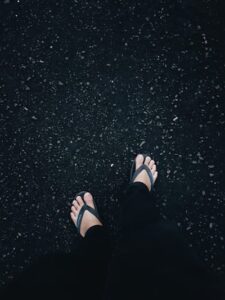
After a long day of hiking or sightseeing, nothing beats slipping into a pair of comfy flip flops. Bonus points if they’re quick-drying and odour-resistant (your fellow travellers will thank you). Flip flops are also a great footwear selection if you happen to be using communal showers because they can help minimise the risk of conditions like tinea or other fungal infections.
Hiking Socks
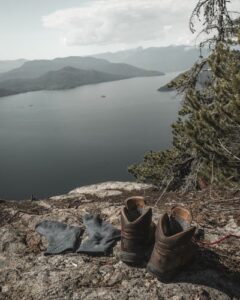
Don’t underestimate the power of a good pair of hiking socks. Look for options with cushioned soles and seamless toes to prevent blisters and hot spots. Merino wool blends are great for temperature regulation and odour control, so you can wear them day after day without stinking up the hotel room or tent.
What Do You Need to Bring For Hiking in Iceland?

Most of the clothing above are essentials to keep you comfortable while getting around the country but if you’re a more serious hiker or trekker there are a few other things to keep in mind that will help to make your Icelandic adventure as seamless as possible.
Walking Poles

Hiking in Iceland often means traversing rugged terrains, steep inclines, and uneven surfaces. Walking poles can be your best friends in such situations, providing stability, balance, and reducing strain on your legs and knees. Look for lightweight, collapsible poles that you can easily attach to your backpack when not in use. Alternatively it is possible to rent them when you arrive in the country.
Backpack Rain Cover
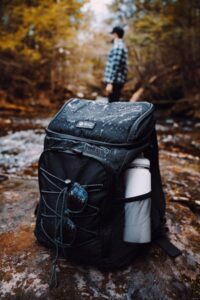
Iceland’s weather can be notoriously unpredictable, even during the summer months. A sudden downpour can turn a pleasant hike into a soggy affair in no time. Protect your gear from getting drenched by investing in a backpack rain cover. These lightweight covers are designed to slip over your backpack, keeping your belongings dry and protected from the elements.
Head Net
While Iceland may not have a reputation for pesky insects like some other destinations, certain areas, especially near water bodies or marshlands, can attract midges and other annoying bugs during the summer months. Iceland is known for not having any stinging or biting insects but these can get quite annoying especially if they swarm in large numbers.
A head net offers a simple yet effective solution to keep these tiny nuisances at bay, allowing you to focus on enjoying the stunning landscapes without constantly swatting away bugs.
Sleep Mask

Iceland’s summer months bring almost endless daylight, with the sun barely dipping below the horizon, especially in the northern regions. While this phenomenon, known as the Midnight Sun, is a unique experience, it can wreak havoc on your sleep schedule if you’re not accustomed to it. A sleep mask can help block out the relentless sunlight, allowing you to catch some much-needed shut-eye, even in the middle of the night.
Quick Dry Towel

Whether you’re caught in a sudden rain shower or taking a refreshing dip in one of Iceland’s many hot springs, a quick-dry towel is an essential item for any hiker.
These lightweight and compact towels absorb moisture quickly and dry rapidly, allowing you to stay comfortable and dry on the go. Look for options made from microfiber material for maximum absorbency and quick drying properties.
A Tent
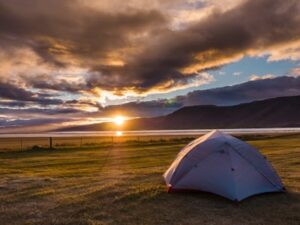
For multi-day hikes or remote wilderness exploration, a sturdy and reliable tent is a must-have item. Look for a lightweight, weatherproof tent that can withstand Iceland’s variable weather conditions, including strong winds and occasional rain showers. Consider factors such as tent capacity, ease of setup, and durability when choosing the right tent for your hiking adventures. Always remember that people are only permitted to camp in designated camping areas and this rule is policed quite heavily so plan ahead and if you don’t see a clear sign saying you may camp, perhaps give it a miss.
Sunglasses

Iceland’s pristine landscapes are a feast for the eyes, but they can also be incredibly bright, especially on sunny days. Protect your eyes from harmful UV rays and glare by wearing sunglasses with polarised lenses. Look for sunglasses that offer full UV protection and wrap-around frames to shield your eyes from all angles.
Camera

With its jaw-dropping scenery and photogenic landscapes, Iceland is a paradise for photography enthusiasts. Don’t forget to pack your camera to capture all the breathtaking moments and unforgettable views along your hiking trails. Whether you prefer a DSLR, mirrorless camera, or smartphone with a high-quality camera, make sure you have a reliable way to document your Icelandic adventures.
An Extra Phone Battery or Power Bank

In today’s digital age, smartphones are indispensable tools for navigation, communication, and capturing memories on the go. However, constant use of GPS, photography, and other apps can quickly drain your phone’s battery, especially during long hikes. Be sure to pack an extra phone battery or portable power bank to keep your devices charged and ready for action, ensuring you never miss a photo opportunity or lose your way on the trail.
Medicines & Prescriptions

Last but certainly not least, don’t forget to pack any essential medications or prescriptions you may need during your hiking adventures in Iceland. Whether it’s allergy medication, pain relievers, or prescription medications, it’s essential to have them on hand in case of emergencies or unexpected health issues. Consider bringing a small first aid kit with basic supplies such as bandages, antiseptic wipes, and blister plasters to deal with minor injuries or ailments on the trail.
Conclusion
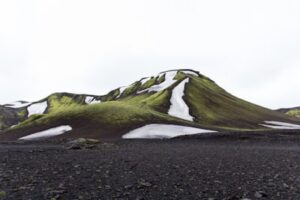
With your bags packed and a sense of adventure in your heart, you’re ready to hit the trails and explore Iceland’s stunning natural beauty. Whether you’re trekking through volcanic landscapes, hiking to hidden waterfalls, or camping under the Midnight Sun, these essential items will ensure you’re prepared for whatever Mother Nature throws your way. So lace up your boots, grab your camera, and get ready to embark on the hiking adventure of a lifetime in the land of fire and ice. Safe travels or as they say in Icelandic, Góða Ferð!

